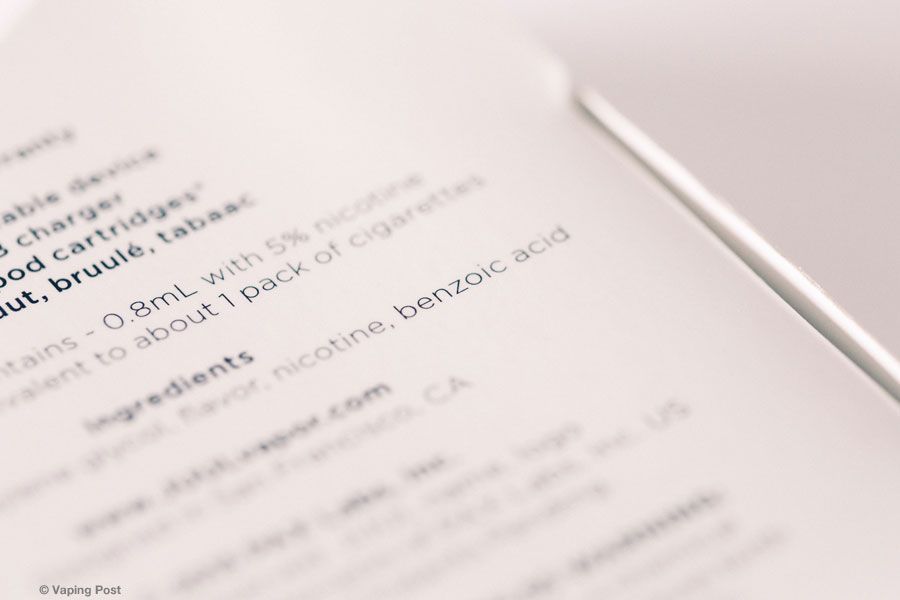The topic of nicotine salts is paradoxically both a minor and a major one, given that it is on many people’s lips, even though they might not be affected. In this section, we will try to summarise the topic, its effects and its potential risks. Full review of the current knowledge on “salted nicotine”.

There’s nicotine and nicotine
The term nicotine salts is somewhat misleading: in fact, they are not in crystal form, but in liquid form. The term “salts” is used merely because the substance is an alkaloid, i.e. a nitrogen-based molecule which, in its fully developed form, forms bitter salts. That is the chemical explanation at least, because in practice, such a form is useless and therefore has no large-scale applications.
To put things more simply: nicotine salts are the form of nicotine closest to that found in the natural state. The nicotine used in vaping e-liquids is a purified nicotine, sometimes known as freebase nicotine. This form of nicotine is processed in two phases. Firstly, it undergoes a chemical treatment calibrated for high-yield extraction, so as to extract as much from a plant as possible. This is followed by a purification.
In the majority of cases, the nicotine extracted is actually the same as that used in insecticidal bases. Highly concentrated in extraction products, it therefore needs to be purified to make it fit for human inhalation. This is known as pharmaceutical-grade nicotine, namely that containing the lowest possible level of extraneous elements.
Haps and mishaps of nicotine
While these successive processes have the merit of providing high-purity nicotine completely safe for consumption in vaping form, they denature the product, which has a number of effects. The nicotine becomes unstable and breaks down. While its nature is unchanged – there is, for example, no risk of transformation into a toxic compound – its effects are impacted by this process. If the nicotine is old and poorly stored, it will not be as effective on the brain’s receptors.
The nicotine extracted from cigarette combustion is closer to the original form than the purified nicotine contained in e-cigarettes.
This is a real problem, as the purified nicotine currently used in vaping is much less effective than in the natural state. We tend to summarise this comparative effectiveness with the rule of two 10s: you need 10 minutes of vaping to obtain the same effect as with 10 seconds of tobacco, strictly in terms of satisfaction of the dedicated receptors in the brain.
The nicotine extracted from cigarette combustion is closer to the original form than the purified nicotine contained in e-cigarettes. Obviously, the health problem posed by tobacco is not due to the nicotine level, but the chemical substances generated by combustion inhaled by the smoker at the same time.
Therefore, there is only one solution for those seeking to quit tobacco: increase the nicotine dose contained in the e-liquid. This creates another problem, that of irritation of the respiratory tract, particularly the throat, by purified nicotine. Though not dangerous in and of itself, this irritation can cause coughing and pain which make for an unpleasant experience.
Nicotine salts to the rescue

Due to their similarity to natural nicotine, nicotine salts are more stable than purified nicotine. This is their first advantage: they are more resilient and therefore are more forgiving in terms of storage quality.
They are especially characterised by a milder vaping experience. Nicotine salts cause less irritation than purified nicotine. As such, they are the ideal tool for vapers, particularly beginners, who need a high nicotine dosage but who are prone to coughing fits.
Due to their similarity to natural nicotine, nicotine salts are more stable than purified nicotine.
In this way, a member of the editorial team had a close family member, who needs a high-dose liquid, but starts coughing from 6 mg/ml of purified nicotine, try out a nicotine salt-based e-liquid. They had no problems with a nicotine salt content of 20 mg. The vaper was able to take the dose without any adverse effects.
Others have told us that, in the United States, where the legislation is much less stringent in terms of dosages, they had tried liquids with nicotine salt contents of around 50 mg/ml. Once again, no irritation or coughing issues were observed. On the other hand, the unfortunate testers who were unaccustomed to such doses experienced dizziness.
Are nicotine salt-based liquids the miracle solution for first-time vapers? Maybe, for those whose mucous membranes are sensitive to nicotine. Not for those who like a throat hit. It has been known for some years now that this contraction of the throat when inhaling nicotine is a key factor in the cessation process for some people. Nicotine salts will not work for these people.
Those available, and in the pipeline
A U.S. company, Pax Labs Inc., set things in motion with the marketing of Juul, a complete vaping system, including a battery and sealed cartridges using nicotine salts. The company promised to facilitate the transition from tobacco cigarettes to vaping.
The leaders in the field of nicotine can be found in the tobacco industry, where all the forms and properties of nicotine have been studied for decades.
Note that Juul was not the pioneer as regards nicotine salts. Once again, the leaders in this field can be found in the tobacco industry, where all the forms and properties of nicotine have been studied for decades. The pioneering product is Steem, developed when Philip Morris purchased a patent dating from 2011. However, the commercial buzz is to be credited to Pax Labs Inc. Therefore, vaping has once again been a gamechanger.
Juul’s commercial success is very significant, and many firms have pounced on the nicotine salt market, either launching branded products, or simply creating nicotine for e-liquids.
Are we seeing a general trend in e-liquids towards nicotine salts?
Nevertheless, we should not expect generalised use of nicotine salts in the years to come: everyone would seem to agree that it is a niche market, which could certainly become sizable and lucrative, but which will not concern most vapers.
First and foremost, due to the virtual lack of a hit from nicotine salt-based liquids. It is not completely absent, but very subdued, for liquids within European standards limited to 20 mg/ml. However, as mentioned above, many tobacco cessation experts in recent years have realised the importance of the vaping throat hit in enabling some smokers transition to a substitute product.
The use of nicotine salts is not recommended for those using a high-power set-up.
The mechanism is undoubtedly purely psychological, but no matter: it works. Nicotine salts are therefore not suitable for these users, as they will not create a satisfactory experience.
The use of nicotine salts is also not recommended for those using a high-power set-up, as it easy to reach overdose levels without any warning sign in the throat. High-power set-ups are experiencing commercial growth, depriving nicotine salts of a significant market.
Finally, there is the most important argument of all, the price. Nicotine salts are more expensive to produce than conventional purified nicotine, and therefore, are more expensive to purchase. The effectiveness of the product certainly compensates for some of this extra cost, but it nonetheless represents a greater expense.
Mass production will undoubtedly help bring these cost prices down, but it will not bring nicotine salts to the same price level as conventional purified nicotine. Even if the difference is ultimately minimal, a vaper who doesn’t have any specific needs that can be met with nicotine salts will undoubtedly opt for a liquid with a more conventional base.
What do the experts think?
Opinion of the tobacco studies expert Jacques Le Houezec.

First of all, there is not much difference between a vaping liquid based on nicotine salts and a liquid based on freebase nicotine. Liquid nicotine is a weak base (in chemical terms) with an alkaline pH. Nicotine salts (originally in crystallised form) diluted in the PG/VG mixture will produce a more acidic liquid. But nicotine is still nicotine! The absorption in the lungs will be similar.
Why use nicotine salts? Simply because the vapour obtained with a liquid containing nicotine salts will cause less irritation in the throat (the famous hit). Both smokers and vapers know how to dose their nicotine intake (titration phenomenon). This will help smokers who are starting to vape to reduce the level of irritation and therefore inhale a vapour with the right nicotine content more easily in order to satisfy their need.
This innovation will undoubtedly help heavy smokers (for whom the limit of 20 mg/ml is not enough), and those with considerable respiratory tract irritation, to tolerate a high dose and therefore be able to quit smoking more easily.
The nicotine experts that we interviewed generally have the same attitude: genuine interest in the product mitigated with a note of caution.
Nicotine salts offer undoubted potential in terms of reducing intake.
For example, Dr Konstantinos Farsalinos, who points out that “nicotine salts offer undoubted potential in terms of reducing intake. A vaper will need to inhale less to gain satisfaction, with a milder throat hit. The potential for rapid nicotine delivery is incredible.”
However, the expert tempers his enthusiasm: “I would be happy to test these products if they are manufactured by the tobacco industry, because I know that they will have researched them extensively, which small independent start-up manufacturing firms are not necessarily able to do.”
Does this come as a surprise? Not really when Dr Farsalinos explains that “the problem lies in the acids used for extracting these nicotine salts. Some are not fit for human consumption, and some of these can even corrode metal tanks. Will these small firms test them for corrosion? Chances are they wouldn’t.”
Konstantinos Farsalinos does not rule them out comply, but, says “I would only test products from independent firms if they have published tests run by accredited laboratories.”
Opinion of Sébastien Roux, Director of Crivape*.

We are neither for nor against the use of nicotine salts in e-liquids for e-cigarettes. The French Public Health Code has a little to say on the subject, and at Crivape, we do not have enough scientific data to date (besides the pH, the CLP of the various acids used, the AFNOR XP standards, etc.) to unambiguously state that this is an amazing, risk-free, non-addictive product that can help some smokers to quit. We have set up an (ongoing) clinical study which will see the production of the first data, by the end of this year, on the uptake of this product in the light of the knowledge recently acquired on free nicotine.
(*Crivape – Vaping Research and Innovation Centre)
To praise or to pillory?
Everyone appears to be singing from the same hymn sheet. The main thrust can be summed up as follows: “It’s an excellent idea, let’s wait and see how it rates on delivery”.
There are still a number of grey areas, and consumers are entitled to expect light to be shed on them.
Let’s be clear: it is not our intention to give nicotine salts our blessing or burn them at the stake. As we have seen, the product in and of itself can provide a solution for some vapers who were not getting satisfaction from traditional purified nicotine, and, if that helps keep them off tobacco cigarettes, it can only be a good thing.
On the other hand, there are still a number of grey areas, and consumers are entitled to expect light to be shed on them before they start using the product.
The first grey area, therefore, concerns the products used for manufacture. Producing tests demonstrating the safety of its production process should be self-evident for each manufacturer.
Indeed, there are many nicotine salt extraction processes. And some manufacturers, when developing their own, file a patent to protect it, or keep their recipe secret under all circumstances. This is the case of Juul and all those arriving on the market.
Under these circumstances, this leaves two possibilities: either companies seeking to manufacture their nicotine salt-based e-liquids will buy this base from a few corporate producers. This is a possibility, and is the case with purified nicotine. Or each company will seek to produce its own nicotine salts. When all the safe extraction methods have been patented, then only extraction methods based on hazardous products will remain. Some may be tempted to take such an irrevocable step.
The second grey area concerns information aimed at consumers. The importance of informing consumers about the fact that they are vaping nicotine salts and the dosage involved is clear. Just imagine the harm an inattentive user could do if they thought they were vaping 1.5 mg purified nicotine, based on guesswork, and they were actually using a liquid containing 20 mg salts on a dripper at 100 W… It wouldn’t be life-threatening, but the user would be the worse for wear.
Some other questions will undoubtedly be added to this list. Ultimately, it doesn’t matter – as you can see from the statements from the firms who responded to our questions, they currently have the process fully under control. Therefore, they will have no difficulty giving users the information to which they are legitimately entitled.
Are we seeing a trend towards a bigger nicotine hit?
Nicotine salts will come into their own, not as a revolutionary product, but as a useful and effective addition to the vaping arsenal for tobacco cessation.
Ultimately, manufacturers may have to start producing nicotine at the other end of the scale: nicotine with an extremely strong hit precisely to satisfy heavy vapers. I still vape 3 mg, but I vape less because of the throat irritation caused. Nicotine salts to start, regular nicotine midway through the cessation process, and nicotine with a strong hit to stop vaping or vape less.













